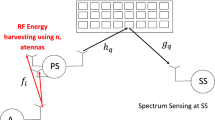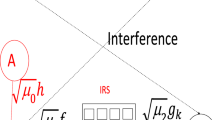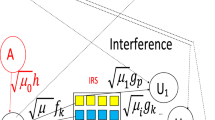Abstract
In this paper, we suggest to optimize harvesting and sensing duration for cognitive radio networks (CRN) using intelligent reflecting surfaces (IRS). The secondary source \(S_S\) harvests energy using the signal of node A. Then, \(S_S\) performs spectrum sensing to detect primary source \(P_S\) activity. When \(P_S\) activity is not detected, \(S_S\) transmits a packet to secondary destination \(S_D\). IRS reflects the signals from the secondary source so that all reflections are in phase at secondary destination. We show that the use of N=8,16,32,64,128, 256,512 reflectors offers 19, 25, 31, 37, 43, 49, 56 dB gain when compared to the absence of IRS [20]. We also propose to add a second IRS between node A and \(S_S\) to increase the harvested energy since \(S_S\) harvests energy using the reflected signals on the first IRS. The use of two IRS with \(N_1=8\) reflectors in the first IRS and \(N_2=8\) reflectors in the second IRS offers 12 dB and 30 dB gain when compared to a single IRS \(N=8\) and the absence of IRS [20]. The use of two IRS with \(N_1=16\) and \(N_2=8\) offers 21 dB and 39 dB gain when compared to a single IRS \(N=8\) and the absence of IRS [20].
Similar content being viewed by others
Avoid common mistakes on your manuscript.
1 Introduction
In CRN, primary and secondary users (PU and SU) share the same spectrum. In interweave CRN, secondary source transmits when primary source is idle. In underlay CRN, secondary source transmits with an adaptive transmit power to generate low interference at secondary destination. In overlay CRN, secondary source dedicates a part of its power to help the secondary destination in decoding its packet. In this paper, we optimize harvesting and sensing durations for interweave CRN using intelligent reflecting surfaces (IRSs). IRSs allow an increase in the throughput of wireless networks since the reflected signals are in phase at the destination [1,2,3,4,5]. IRS is placed between the source and the destination with optimized phase shifts so that all reflections are in phase at the destination [6, 7]. IRS has been suggested for wireless networks as well as non- orthogonal multiple access (NOMA) [8, 9]. IRSs have been used to increase the throughput of optical communications as well as millimeter wave communications [10,11,12]. IRS with finite phase shifts has been suggested in [13]. Asymptotic performance analysis of wireless communications using IRS was provided in [14]. Antenna design, simulations and measurements of wireless communication using IRS were discussed in [15,16,17]. Machine and deep learning algorithms were used to optimize IRS implementation [18, 19]. IRSs are nearly passive devices, made of electromagnetic material that can be deployed in primary or secondary networks of CRN on several structures, including but not limited to building facades, indoor walls, aerial platforms, roadside billboards, vehicle windows, etc.
In this article, we optimize harvesting and sensing duration for CRN using IRS. The secondary source \(S_S\) harvests energy using the signal of node A. Then, \(S_S\) performs spectrum sensing to detect the activity of \(P_S\). When \(P_S\) activity is not detected, \(S_S\) transmits a packet to secondary destination \(S_D\). The transmitted signal by \(S_S\) is reflected by N reflectors of IRS so that all reflections are in phase at \(S_D\). We show that the use of \(N=8,16,32,64,128,256,512\) reflectors offers 19, 25, 31, 37, 43, 49, 56 dB gain when compared to the absence of IRS [20]. We also propose to add a second IRS between node A and \(S_S\) to increase the harvested energy since \(S_S\) harvests energy using the reflected signals on the first IRS. The use of two IRS with \(N_1=8\) reflectors in the first IRS and \(N_2=8\) reflectors in the second IRS offers 12 dB and 30 dB gain when compared to a single IRS \(N=8\) and the absence of IRS [20]. The use of two IRS with \(N_1=16\) and \(N_2=8\) offers 21 dB and 39 dB gain when compared to a single IRS \(N=8\) and the absence of IRS [20]. IRS with adaptive transmit power was studied in [21].
Next section derives the throughput when there is a single IRS. Section 3 proposes to add a second IRS to increase the harvested energy. Section 4 shows the throughput enhancement using a single or two IRS. Conclusions and perspectives are presented in Sect. 5.
2 CRN with one IRS
Figure 1 depicts the system model with a secondary source (\(S_S\)) equipped with \(n_r\) receive antennas used to harvest energy over aT seconds using the signal of node A. \(0<a<1\) is the harvesting percentage and T is the frame duration. \(S_S\) performs spectrum sensing to detect primary source \(P_S\) activity during \((1-a)bT\) seconds where \(0<b<1\) provides the sensing duration. When \(P_s\) activity is not detected, \(S_S\) transmits data to secondary destination \(S_D\) over \((1-b)(1-a)T\) seconds. The transmitter signal is reflected on IRS equipped with N reflectors so that all reflections are in phase at \(S_D\). A Rayleigh fading channel is used during the simulations.
The harvested energy at \(S_S\) is expressed as
where \(\mu \) is the efficiency of energy conversion, \(P_A=\frac{E_A}{T_s}\) is the power of A, \(T_s\) is the symbol period, \(L_0=\frac{T}{T_s}\). The average power of channel gain \(f_l\) between A and l-th antenna of \(S_S\) is \(E(|f_l|^2)=\frac{1}{D_1^{ple}}\) where E(X) is the expectation of X, \(D_1\) is the distance between A and \(S_S\), and ple is the path loss exponent.
The symbol energy of \(S_S\) is computed as
Let \(h_q\) be the channel gain between \(S_S\) and q-th reflector of IRS. Let \(g_q\) be the channel gain between q-th reflector of IRS and \(S_D\). \(h_q\) follows a zero mean Gaussian distribution with \(E(|h_q|^2)=\frac{1}{D_2^{ple}}\) where \(D_2\) is the distance between \(S_S\) and IRS. \(g_q\) follows a zero-mean Gaussian distribution with \(E(|g_q|^2)=\frac{1}{D_3^{ple}}\) where \(D_3\) is the distance between IRS and \(S_D\).
We have \(h_q=a_qe^{-jb_q}\) where \(a_q=|h_q|\) and \(b_q\) is the phase of \(h_q\) such that \(E(a_q)=\frac{\sqrt{\pi }}{2\sqrt{D_2^{ple}}}\) and \(E(a_q^2)=E(|h_q|^2)=\frac{1}{D_2^{ple}}\) [25]. We have \(g_q=c_qe^{-jd_q}\) such that \(E(c_q)=\frac{\sqrt{\pi }}{2\sqrt{D_3^{ple}}}\) and \(E(c_q^2)=E(|g_q|^2)=\frac{1}{D_3^{ple}}\).
The phase of q-th reflector is [1]
The received signal \(S_D\) is written as
where \(s_p\) is the p-th transmitted symbol and \(n_p\) is a Gaussian noise of variance \(N_0\).
Using (3), we obtain
The signal-to-noise ratio (SNR) at \(S_D\) is written as [1]
Using (2), we obtain
For a large number of reflectors, i.e., \(N\ge 8\), \(\sum _{q=1}^N a_qc_q\) follows a Gaussian distribution with mean \(m=\frac{N \pi }{4\sqrt{D_2^{ple}D_3^{ple}}}\) and variance \(\sigma ^2=\frac{N}{D_2^{ple}D_3^{ple}}[1-\frac{\pi ^2}{16}]\). As \([\sum _{q=1}^N a_qc_q]^2\) is non-central Chi-square r.v. and \(\sum _{l=1}^{n_r} |f_l|^2\) is a central chi-square r.v, the probability density function (PDF) of \(\gamma ^{S_D}\) is written as [22]
We use [23]
to obtain
where \(G_{n,m}^{p,l}(x)\) is the Meijer G-function.
We deduce the cumulative distribution function (CDF) of \(\gamma ^{S_D}\):
The packet error probability (PEP) at \(S_D\) can be computed as [24]
where \(W_0\) is defined as [24]
pep(v) is the PEP for for Q-QAM modulation [25]
and PL is packet length in symbols.
The throughput at \(S_D\) is computed as
where B is the used bandwidth, \(P_f(a,b)\) is the false alarm probability written as
\(\zeta \) is the energy detector threshold, \(\lfloor (1-a)b L_0\rfloor \) is the number of samples employed by the energy detector, and \(\lfloor x \rfloor \) is the integer part of x,
Harvesting duration a and sensing duration b are optimized to maximize the throughput:
3 CRN using two IRS
Figure 2 depicts a system model containing two IRS: \(IRS_1\) is used for increase the harvested energy with \(N_1\) reflectors . \(IRS_1\) is between A and \(S_S\) to increase the harvested energy. \(IRS_2\) is located between \(S_S\) and \(S_D\); it contains \(N_2\) reflectors to increase the SNR at \(S_D\).
When \(IRS_1\) is used, the harvested energy is equal to
\(\delta _l=|u_l|\), where \(u_l\) is channel gain between A and l-th reflector of \(IRS_1\), and \(\eta _l=|v_l|\) where \(v_l\) is the channel gain between l-th reflector of \(IRS_1\) and \(S_S\).
For large values of \(N_1\ge 8\), \([\sum _{l=1}^{N_1}\delta _l\eta _l]\) follows a Gaussian distribution with mean \(m_2=\frac{N_1\pi }{4\sqrt{D_4^{ple}D_5^{ple}}}\) and variance \(\sigma _2^2=\frac{N_1}{D_4^{ple}D_5^{ple}}\). \(D_4\) is the distance between A and \(IRS_1\), and \(D_5\) is the distance between \(IRS_1\) and \(S_S\).
We can write
The SNR at \(S_D\) is equal to
where \(a_q\), \(c_q\) were defined in Sect. 2 and \(N_2\) is the number of reflectors of \(IRS_2\).
As \([\sum _{l=1}^{N_1}\delta _l\eta _l]^2\) and \([\sum _{q=1}^{N_2} a_qc_q]^2\) are two non-Chi-square r.v., the PDF of \(\gamma ^{S_D}\) is written as [22]
Using (10), the CDF of \(\gamma ^{S_D}\) is equal to
where \(m_3=\frac{N_2^2 \pi }{4\sqrt{D_2^{ple}D_3^{ple}}}\), \(\sigma _3^2=\frac{N_2^2}{D_2^{ple}D_3^{ple}}[1-\frac{\pi ^2}{16}]\).
4 Numerical results
Figures 3, 4 and 5 depicts the throughput for QPSK, 16 and 64 QAM modulation in the presence of one IRS with \(M=8\) reflectors for \(\zeta =1\), \(D_1=1\), \(D_2=1.3\), \(D_3=1.4\), \(E_A=1\). We notice that the optimization of harvesting and sensing duration offers the largest throughput when compared to \(a=1/3\), \(b=1/2\), optimal a, \(b=1/2\) and optimal b with \(a=1/3\).
For the same parameters as Figs. 3, 4 and 5, Figures 6 and 7 show the throughput for 16 and 64 QAM modulations and different number of reflectors \(N=8,16,32,64,128,256,512\). The use of \(N=8,16,32,64,128,256,512\) reflectors offers 19, 25, 31, 37, 43, 49, 56 dB gain when compared to the absence of IRS [20]. In Fig. 6-7, we used an optimal value of a and b.
Figure 8 shows the effect of number of harvesting antennas \(n_r=1,2,3\) on secondary throughput for QPSK modulation, \(N=8\) reflectors and the same parameters as Fig. 3. We notice that \(n_r=3\) harvesting antennas offers 2 dB and 7 dB gain when compared to \(n_r=2,1\).
Figure 9 depict the throughput for QPSK modulation when there are two IRS with \(D_4=1.1\) and \(D_5=1.2\). The other parameters are the same as Fig. 3. The use of two IRS with \(N_1=8\) reflectors in the first IRS and \(N_2=8\) reflectors in the second IRS offers 12 dB and 30 dB gain when compared to a single IRS \(N=8\) and the absence of IRS [20]. The use of two IRS with \(N_1=16\) and \(N_2=8\) offers 21 dB and 39 dB gain when compared to a single IRS \(N=8\) and the absence of IRS [20].
5 Conclusion and perspectives
In this article, we optimized harvesting and sensing duration for CRN using intelligent reflecting surfaces (IRS). IRS reflects signals from secondary source so that all reflections are in phase at secondary destination. The use of \(N=8,16,32,64,128,256,512\) reflectors offers 19, 25, 31, 37, 43, 49, 56 dB gain when compared to the absence of IRS [20]. We also proposed to add a second IRS to increase the harvested energy where the secondary source harvests energy using the reflected signals on the first IRS. The use of two IRS with \(N_1=8\) reflectors in the first IRS and \(N_2=8\) reflectors in the second IRS offers 12 dB and 30 dB gain when compared to a single IRS \(N=8\) and the absence of IRS [20]. The use of two IRS with \(N_1=16\) and \(N_2=8\) offers 21 dB and 39 dB gain when compared to a single IRS \(N=8\) and the absence of IRS [20]. As a perspective, we may extend the system model to NOMA systems.
References
Basar, E., Di Renzo, M., De Rosny, J., Debbah, M., Alouini, M.S., Zhang, R.: Wireless Communications Through Reconfigurable Intelligent Surfaces. IEEE Access 7, 116753–116773 (2019)
Zhang, H., Di, B., Song, L. and Han, Z.: Reconfigurable Intelligent Surfaces Assisted Communications With Limited Phase Shifts: How Many Phase Shifts Are Enough?. IEEE Trans. Vehicular Technol. 69: 4498-4502.(2020)
Di Renzo, M: 6G Wireless: Wireless Networks Empowered by Reconfigurable Intelligent Surfaces. 2019 25th Asia-Pacific Conference on Communications (APCC)
Basar, Ertugrul: “Reconfigurable Intelligent Surface-Based Index Modulation: A New Beyond MIMO Paradigm for 6G", IEEE Transactions on Communications, Early Access Article, (2020)
Wu, Q., Zhang, R: Towards smart and reconfigurable environment: intelligent reflecting surface aided wireless network. IEEE Commun. Magazine, 58 (2020)
Huang, C., Zappone, A., Alexandropoulos, G.C., Debbah, M. and Yuen, C.: Reconfigurable intelligent surfaces for energy efficiency in wireless communication. IEEE Trans. Wireless Commu., 18, 4157-4170. (2019)
Alexandropoulos, G.C. and Vlachos, E.: A hardware architecture for reconfigurable intelligent surfaces with minimal active elements for explicit channel estimation. ICASSP 2020 - 2020 IEEE International Conference on Acoustics, Speech and Signal Processing (ICASSP), (2020)
Guo, H., Liang, Y.C., Chen, J., Larsson, E.G.: Weighted sum-rate maximization for reconfigurable intelligent surface aided wireless network. IEEE Trans. Wireless Commun. 19, 3064-3076 (2020)
Thirumavalavan, V.C. and Jayaraman, T.S.: BER analysis of reconfigurable intelligent surface assisted downlink power domain NOMA system. 2020 International Conference on COMmunication Systems and NETworkS (COMSNETS), (2020)
Yang, L., Guo, W. and Ansari, I.S: Mixed dual-hop FSO-RF communication systems through reconfigurable intelligent surface. IEEE Commun. Lett. Early Access Article, (2020)
Pradhan, C., Li, A., Song, L., Vucetic, B. and Li, Y.: Hybrid precoding design for reconfigurable intelligent surface aided mmWave communication systems. IEEE Wireless Commun. Lett. 9(7), 1041-1045. (2020)
Ying, K., Gao, Z., Lyu, S., Wu, Y., Wang, H. and Alouini, M.S.: GMD-based hybrid beamforming for large reconfigurable intelligent surface assisted millimeter-wave massive MIMO, IEEE Access, 8, 19530-19539. (2020)
Di, B., Zhang, H., Li, L., Song, L., Li, Y. and Han, Z.: Practical hybrid beamforming with finite-resolution phase shifters for reconfigurable intelligent surface based multi-user communications. IEEE Trans. Vehicular Technol. 69(4), 4565-4570. (2020)
Kammoun, A., Chaaban, A., Debbah, M. and Alouini, M.S.: Asymptotic max-min SINR analysis of reconfigurable intelligent surface assisted MISO systems. . IEEE Transactions on Wireless Communication 19, 7748-7764 (2020)
Zhao, W., Wang, G., Atapattu, S., Tsiftsis, T.A. and Tellambura, C.: Is backscatter link stronger than direct link in reconfigurable intelligent surface-assisted system?. IEEE Commun. Lett. 24, 1342-1346. (2020)
Li, S., Duo, B., Yuan, X., Liang, Y.C. and Di Renzo, M.: Reconfigurable intelligent surface assisted UAV communication: Joint trajectory design and passive beamforming. IEEE Wireless Commun. Lett. 9, 716-720.(2020)
Dai, L., Wang, B., Wang, M., Yang, X., Tan, J., Bi, S., Xu, S., Yang, F., Chen, Z., Di Renzo, M. and Chae, C.B.: Reconfigurable intelligent surface-based wireless communications: Antenna design, prototyping, and experimental results. IEEE Access, 8, 45913-45923. (2020)
Hua, S., Shi, Y.: Reconfigurable intelligent surface for green edge inference in machine learning. 2019 IEEE Globecom Workshops (GC Wkshps), (2019)
Huang, C., Alexandropoulos, G.C., Yuen, C. and Debbah, M.: Indoor signal focusing with deep learning designed reconfigurable intelligent surfaces. 2019 IEEE 20th International Workshop on Signal Processing Advances in Wireless Communications (SPAWC), (2019)
Raed Alhamad, Hatem Boujemaa, "Optimal harvesting and sensing durations for cognitive radio networks", Signal Image Video Process. 14(7), 1397–1404 (2020)
Alhamad, R.:Non orthogonal multiple access with adaptive transmit power and energy harvesting using intelligent reflecting surfaces for cognitive radio networks. Submitted to Signal Image Video Process, (2021)
Wells, W.T., Anderson, R. L., Cell, John W.: The Distribution of the Product of Two Central or Non-Central Chi-Square Variates. Ann. Math. Statistics 33(3), 1016–1020 (1962)
Marzieh Najafi, Vahid Jamali, Panagiotis D. Diamantoulakis, George K. Karagiannidis and Robert Schober, "Non-Orthogonal Multiple Access for FSO Backhauling", IEEE WCNC, Barcelona 2018
Xi, Y., Burr, A., Wei, J.B., Grace, D.: A general upper bound to evaluate packet error rate over quasi-static fading channels. IEEE Trans. Wireless Communications 10(5), 1373–1377 (2011)
Proakis, J.: Digital Communications, 5th edn. Mac Graw-Hill (2007)
Author information
Authors and Affiliations
Corresponding author
Additional information
Publisher's Note
Springer Nature remains neutral with regard to jurisdictional claims in published maps and institutional affiliations.
Rights and permissions
About this article
Cite this article
Alhamad, R. Optimal harvesting and sensing durations for multi-antenna cognitive radio networks using intelligent reflecting surfaces. SIViP 16, 931–936 (2022). https://doi.org/10.1007/s11760-021-02037-7
Received:
Revised:
Accepted:
Published:
Issue Date:
DOI: https://doi.org/10.1007/s11760-021-02037-7













